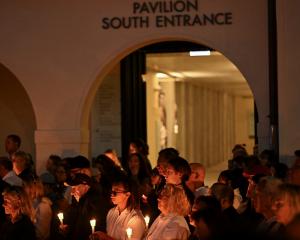
Tempers began to fray in Mexico City on Friday as the search for survivors amidst twisted rubble of collapsed buildings became increasingly desperate three days after the country's most deadly earthquake in a generation.
Tuesday's 7.1 magnitude quake leveled 52 buildings in the sprawling Mexican capital, leaving thousands homeless and close to 300 people dead. Apartment blocks, a school and a textile factory were among the structures that were destroyed.
Human chains of rescuers sped up efforts, assisted by dogs and heat sensors, refusing to give up hope of finding survivors.
Efforts were not fast enough, though, for some family members waiting outside an office building that collapsed in the fashionable Roma neighborhood.
As storm clouds gathered over the city, families worried that rain could slow the pace of rescue efforts.
Protesters held signs addressed to President Enrique Pena Nieto and Mexico City Mayor Miguel Angel Mancera.
"Mancera and EPN: We demand results" read one sign. "They are still alive. Don't kill them" and "We don't want machines" read others, referring to rumors that the military would use bulldozers to hasten removal of rubble deemed unlikely to harbor survivors.
President Enrique Pena Nieto insisted rescue operations would continue, despite dimming chances of finding anyone else alive.
Mexican soldiers and volunteers, supported by teams from as far afield as Israel and Japan, have so far rescued at least 60 people from the ruins in Mexico City and surrounding towns.
Across the city, thousands of rescue workers and special teams using sniffer dogs combed wreckage. For many the search was highly personal.
Firefighter Teresa Ramirez Flores (40) was helping search an office building in Mexico City's Roma neighborhood where her cousin Carolina Muniz, a 43-year-old accountant, was on the second floor when the building collapsed.
"I would happily lose my life doing this, even more so because my cousin is inside," Ramirez said, describing a feeling of impotence as she tried to reach her cousin.
"We want to be superheroes so that our country doesn't suffer," she said at a site where volunteers brought a wheelbarrow filled with candy for the rescue teams.
After three days, rescuers were finding more dead bodies than survivors, but authorities said that signs of life had been picked up by dogs and sensors at several sites.
On a number occasions, hundreds of rescuers broke into spontaneous renditions of Mexico's national anthem.
"I was surrounded by people who I had never seen before and I may never see again, but in this moment we were brothers," said Alejandro Barrera, a 27-year-old volunteer carrying rubble in a human chain for the second consecutive day.
"I won't get tired until they don't need the brigades any more," Barrera said, his name written on his arm to identify him in case he was injured.
EXHAUSTION, FRUSTRATION, BIG BLUNDER
Tuesday's massive quake struck on the anniversary of the deadly 1985 tremor that killed some 5000 people in Mexico City.
As the shock of this week began to subside, exhaustion crept in, along with growing discontent.
On Thursday, Mexico's Navy apologised for communicating incorrect information in a story about a girl supposedly trapped under a collapsed school in Mexico City.
A frantic effort had been made to reach the child, dubbed Frida Sofia by local media, but it turned out that the widely-publicized story had been false, leading to anger.
Francisco Ortiz questioned whether attention directed at trying to rescue the phantom girl had diverted resources from other places where they were desperately needed, like the apartment building where his sister, Maria, was trapped beneath debris.
Authorities had waited until Thursday to begin searching the building. The owner, Juan Salazar, said all the renters had been accounted for before realizing that Ortiz's sister Maria, a maid, had been washing clothes on the roof when the quake struck.
Salazar said he called civil protection and also implored passing brigades of rescue workers to help, but it was two days before rescue efforts began.
"It was negligence. Nobody wanted to take responsibility, neither the army nor Civil Protection," said Ortiz. "We are hoping for something good from God."
On Friday afternoon, after a full day's search, rescuers pulled Maria's body from the rubble.
HOMELESS, FORGOTTEN
Across the city of 20 million people, many whose dwellings had become uninhabitable sought a place to call home, raising the specter of a housing shortage. Senior officials said there could be 20,000 badly damaged homes in the states of Morelos and Puebla.
In the hard-hit Roma neighborhood, Jorge Hernandez and a team of volunteers from Mexico City packed up to move on to isolated villages in Morelos. He said they were doing so after military commands declined their assistance.
Mexico City "is over saturated with support and there are very remote communities in Morelos that have not received help. That's why we are going there. There, they need so much help," Hernandez said.
As signs of tensions surfaced, the country's unpopular political class strove to shine.
Disaster relief is sensitive for politicians in Mexico after the government's widely criticized response to the 1985 quake caused upheaval, which some credited with weakening the one-party rule of the Institutional Revolutionary Party (PRI).
The PRI said in a statement that it would be donating $US14.4 million ($NZ19.6 million), or 25% of its annual federal funding, to help those affected by the earthquake.
After news of the PRI plans, leftist presidential hopeful Andres Manuel Lopez Obrador upped the ante, proposing donating 50% of his National Regeneration Movement party's 2018 federal funding to support victims, an offer matched by the conservative National Action Party.
The full scale of the damage has not been officially calculated although the United States Geological Survey estimated it at up to $US10 billion.












